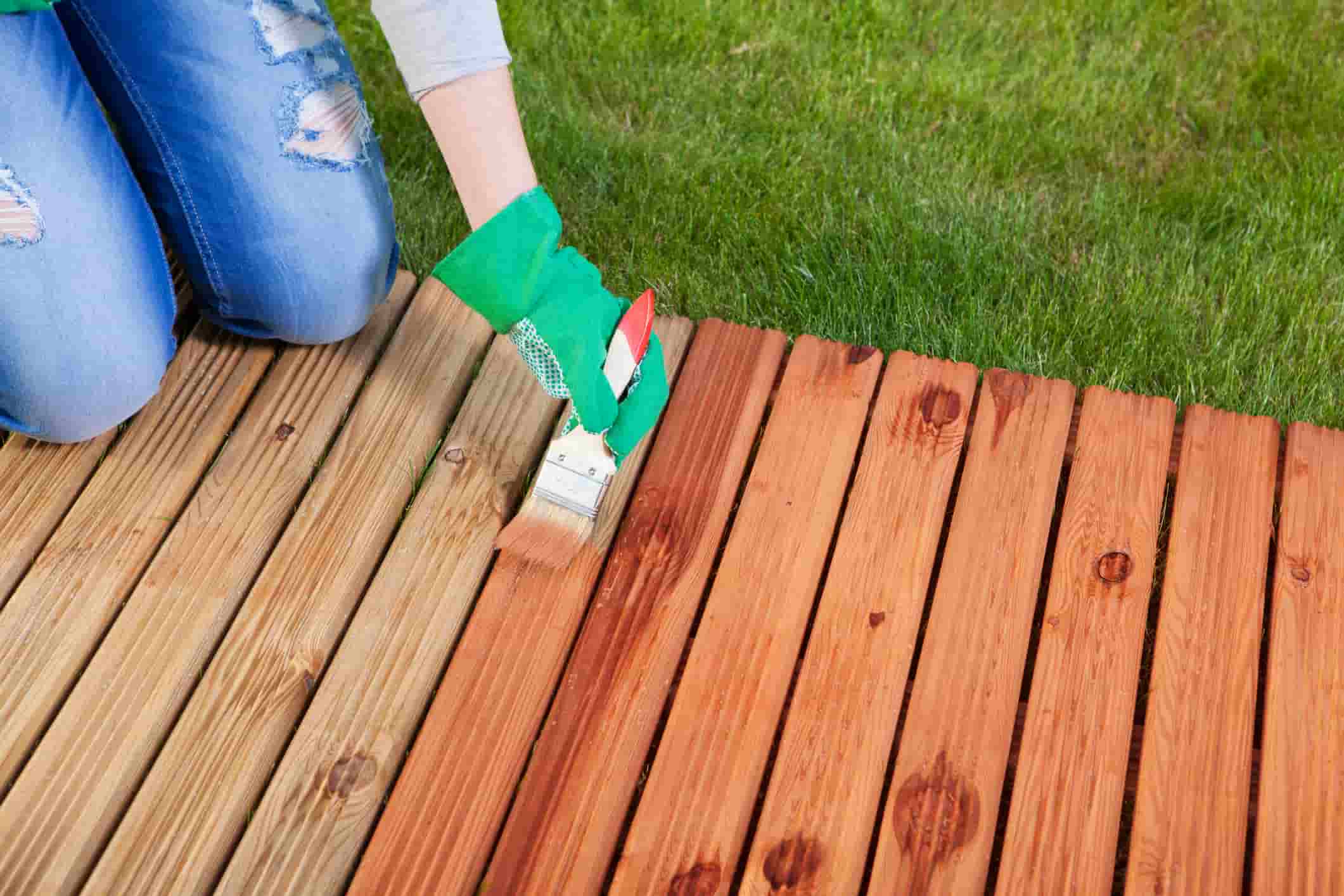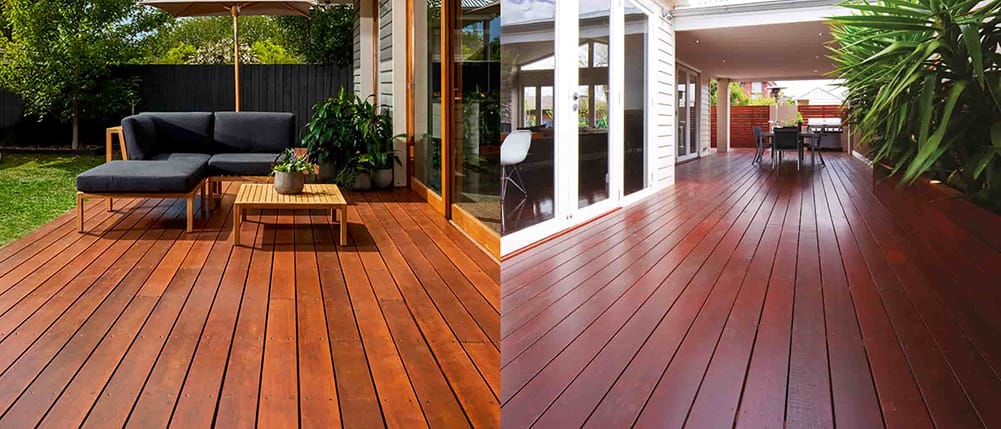- Free Estimates

✔ Deck painting provides full coverage and hides imperfections, while deck staining enhances the wood’s natural look.
✔ Painted decks create a strong moisture barrier, but stained decks adapt better to temperature changes.
✔ Deck painting lasts longer but requires more prep and repairs, while deck staining needs frequent reapplication but is easier to maintain.
✔ Painting a deck involves sanding, priming, and multiple coats, whereas staining requires less prep and dries faster.
✔ Older or damaged decks benefit from deck painting, while newer or high-quality wood decks look best with deck staining.
✔ The best time for deck painting or deck staining in Fairfield, CT is during mild, dry weather with moderate temperatures.
✔ Regular deck maintenance, including cleaning and touch-ups, extends the life of both paint and stain finishes.
Aspect | Deck Painting | Deck Staining |
Color and Finish | – Offers solid, uniform coverage that completely masks the wood’s natural grain.
– Available in a wide range of colors, allowing customization to match home exteriors. | – Enhances the wood’s natural beauty by highlighting grain patterns and texture.
– Limited color options, usually in shades of brown, gray, and cedar tones. |
Imperfection Coverage | – Hides flaws like cracks, discoloration, and past damage, making it ideal for older decks.
– Creates a smooth, even surface that looks fresh and polished. | – Penetrates the wood rather than coating it, so existing imperfections remain visible. – Works best on newer or well-maintained decks with minimal surface damage. |
Sheen and Texture | – Can have a glossy, semi-gloss, or matte finish, depending on the paint formula.
– Creates a sleek, uniform surface that feels smooth underfoot. | – Comes in transparent, semi-transparent, or solid stains that adjust the level of wood visibility.
– Leaves a more natural, textured feel that blends into outdoor environments. |
✔ For a sleek, uniform look with full coverage, deck painting is ideal, while deck staining preserves the wood’s natural grain for a more organic appearance.
Decks in Fairfield, CT face extreme weather, from humid summers to icy winters, making deck maintenance crucial for long-term durability. Deck painting forms a thick barrier against moisture, while deck staining penetrates the wood to provide water resistance without sealing it completely. The level of protection each option offers directly affects how well a deck withstands harsh conditions.
Aspect | Deck Painting | Deck Staining |
Moisture Resistance | – Creates a solid, non-porous layer that blocks water from seeping into the wood. – Prevents swelling, warping, and rot but may trap moisture if cracks develop. | – Absorbs into the wood to repel water while allowing natural airflow. – Reduces the risk of warping but needs reapplication more often than deck painting. |
UV and Sun Damage | – Offers high UV protection by fully covering the wood’s surface. – Prevents fading and sun damage, making it one of the best deck finishes for sunny areas. | – Reduces UV exposure but does not block it completely unless using a solid stain. – Lighter stains fade faster, requiring more frequent deck maintenance. |
Seasonal Durability | – Holds up well in cold, snowy conditions by sealing wood against moisture intrusion. – More prone to cracking and peeling in humid or fluctuating temperatures. | – Expands and contracts with the wood, making it less likely to crack in extreme weather. – Wears down faster in high-traffic areas or after heavy rain and snow. |
✔ Deck painting provides a stronger shield against sun and moisture, but deck staining adapts better to temperature changes, reducing the risk of cracking or peeling.
A deck’s finish impacts not only its appearance but also the time and effort required to keep it in top shape. Deck painting lasts longer but requires more extensive repairs when it starts to fail, while deck staining needs frequent reapplication but wears away more naturally. Choosing the right option depends on long-term deck maintenance preferences.
Aspect | Deck Painting | Deck Staining |
Lifespan | – Lasts 7-10 years when properly applied and maintained. – Requires high-quality paint and a solid primer to reach maximum durability. | – Needs reapplication every 2-3 years, depending on stain type and exposure. – Wears down more quickly in areas with heavy foot traffic or full sun. |
Peeling and Flaking | – Can peel, chip, or bubble over time, especially if moisture gets trapped underneath. – Requires sanding and scraping before repainting, making refinishing labor-intensive. | – Fades gradually instead of peeling, creating a more natural aging process. – Requires cleaning and re-staining but does not need full removal like deck painting. |
Ease of Touch-Ups | – Harder to patch small problem areas without visible inconsistencies. – Matching older paint colors can be challenging due to fading and wear. | – Touch-ups blend more seamlessly since stain soaks into the wood rather than sitting on top. – Easier to refresh without needing full refinishing. |
✔ Deck painting lasts longer but requires extensive prep work for repairs, while deck staining needs more frequent applications but is easier to maintain over time.

The time and effort required to prepare a deck for refinishing can influence the choice between deck painting and deck staining. Deck painting demands extensive prep work to ensure a smooth, even coat, while deck staining requires less effort but still needs proper cleaning and drying. Both options benefit from a well-prepped surface to achieve the best deck finishes.
Aspect | Deck Painting | Deck Staining |
Surface Preparation | – Requires sanding, scraping, and sometimes priming to ensure proper adhesion. – Old paint must be fully removed if it’s peeling or cracking. | – Needs thorough cleaning to remove dirt, mildew, and old stain residue. – Some stains require light sanding, but full removal isn’t necessary. |
Drying and Curing Time | – Takes longer to dry between coats, with full curing often requiring several days. – Humid or rainy weather can delay the process, affecting deck maintenance schedules. | – Dries faster than deck painting, often within a few hours. – Some oil-based stains require extra curing time before use. |
Application Process | – Typically needs multiple coats, including primer and topcoat, for full coverage. – Must be applied carefully to avoid streaks and uneven buildup. | – Usually requires just one or two coats, depending on the stain type. – Can be applied with a brush, roller, or sprayer for quick and even coverage. |
✔ Deck painting involves more labor-intensive prep and longer drying times, while deck staining is faster to apply but still requires proper surface cleaning.
The condition of a deck plays a major role in whether deck painting or deck staining is the better choice. Older, more weathered decks benefit from deck painting, while well-maintained or newly built decks often look best with deck staining. Choosing the right finish ensures the best balance between protection and aesthetics.
Aspect | Deck Painting | Deck Staining |
Older or Damaged Decks | – Best for covering surface flaws, including cracks, stains, and discoloration. – Hides uneven textures, making an aging deck look newer. | – Does not hide imperfections, so cracks and past damage remain visible. – Works only if the deck is structurally sound and in good condition. |
New or High-Quality Wood Decks | – Covers natural wood grain, reducing the impact of premium materials. – May not be the best choice for expensive hardwoods like cedar or mahogany. | – Ideal for showcasing high-quality wood with its natural variations and character. – Enhances rather than hides the beauty of newer decks. |
Decks with High Foot Traffic | – Holds up well against heavy use but may show scuff marks over time. – Requires protective coatings to prevent premature wear. | – Wears down gradually, with areas of heavy use needing more frequent restaining. – Best suited for decks that are regularly maintained and refreshed |
✔ Deck painting works best for older or damaged decks needing full coverage, while deck staining is ideal for newer decks that showcase high-quality wood.
Over time, exposure to sun, rain, and foot traffic wears down a deck’s protective finish, making regular deck maintenance essential. Painting a deck costs between $500 and $2,000 on average, and refreshing it at the right time helps prevent costly repairs while keeping outdoor spaces looking their best. These simple tests can determine whether deck painting or deck staining is due for a refresh.

A freshly painted deck enhances curb appeal and extends the life of outdoor spaces, but getting a flawless, long-lasting finish requires expert care. Fairfield Painting Contractors in Fairfield, CT specializes in deck painting, delivering smooth, even coverage that protects against weather, moisture, and daily wear. With high-quality paints and precise application, their team ensures durable, professional results tailored to the local climate.
Contact them today for a consultation!